Intel Developer Forum 2016: 20 Cool Products That Will Turn Partners' Heads
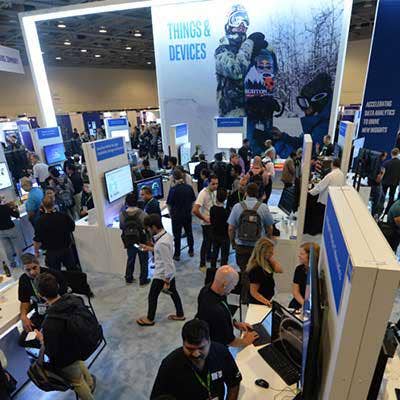
Cutting-Edge, Cool Products
Intel Developer Forum kicked off this week in San Francisco with a bevy of cool new products, including powerful processors, connected devices, and other gadgets that system builders will love.
The conference, which occurs annually and outlines Intel's strategies going into the next year, was under a higher level of scrutiny this year – just in April, CEO Brian Krzanich said Intel was undergoing a major restructuring to focus more on connected devices, cloud, data center and the Internet of Things.
This announcement marked a move away from the company's traditional PC market, and partners have been looking at IDF to see exactly what products the Santa Clara, Calif.-based company has up its sleeve to accelerate its move toward the Internet of Things. Following are the 20 coolest devices that we saw at IDF this year.
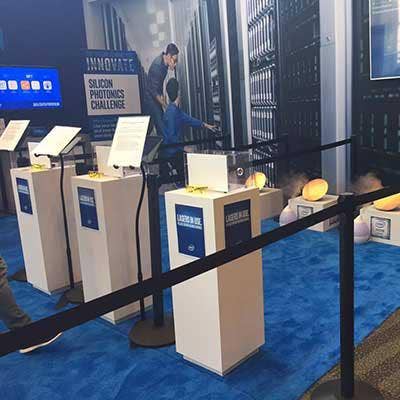
Xeon Phi
Intel paved out a strategy for a bigger role in artificial intelligence with its announcement Wednesday that its newest version of Xeon Phi will have added features around AI.
Xeon Phi processors, which are used in data centers and are already being used for deep-learning applications, will be able to accelerate tasks and software associated with artificial intelligence – helping machines interpret speech and pilot autonomous vehicles.
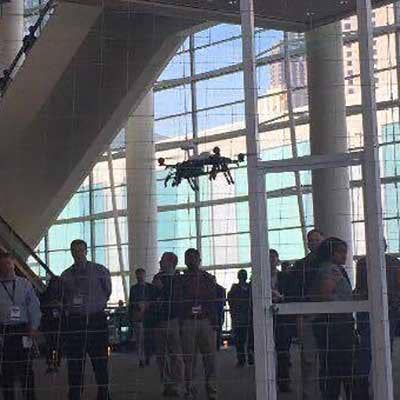
Aero Ready
Intel showcased its Aero platform for unmanned aerial vehicles, called Aero Ready. This quadcopter features a compute board, integrated depth and vision capabilities using Intel's RealSense depth perception technology — which the company says is the fastest path available from Intel for developers to get applications airborne.
Aero Ready To Fly Drone supports several "plug and play" options, including a flight controller with Dronecode PX4 software, Intel RealSense for vision and AirMap SDK for airspace services. The Aero compute board is available for $399 and the AeroReady platform will be available by the end of the year.
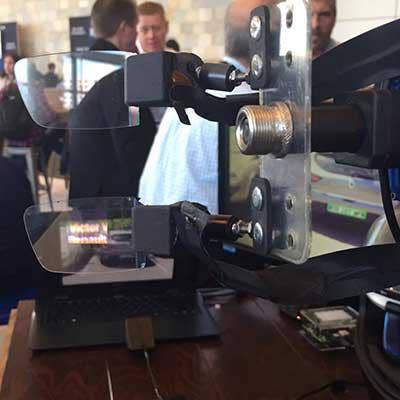
Remote EyeSight Smart Glasses
Intel showed off glasses with augmented reality capabilities during its show, a product that "transform Intel's enterprise collaboration experiences with secure, cost-effective, hands-free and augmented reality technologies."
These glasses, which use Intel's Collaboration Suite for WebRTC video capabilities, were showcased as an application for car dealerships. When users looked at certain cars while wearing the glasses, they were able to see the model, make and price as part of the glasses' augmented reality capabilities.
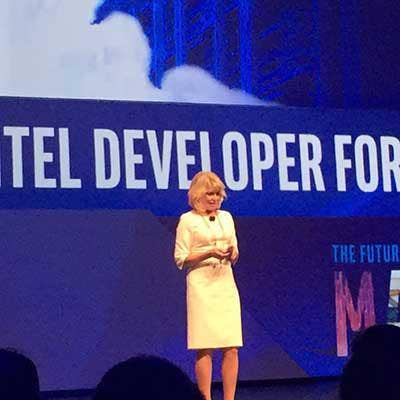
Silicon Photonics 'Available In Volume'
Intel's data center executive, Diane Bryant, announced Wednesday that the company is beginning volume shipments of its Silicon Photonics networking technology – which, she said, has been 16 years in the making.
These optical-networking components use light through thin glass fiber, as opposed to copper wires, creating high-speed systems for data centers. The product, which Intel said delivers 100 Gbps, also has a cost advantage because it is automatically aligned – while the cost of fiber optics is growing.
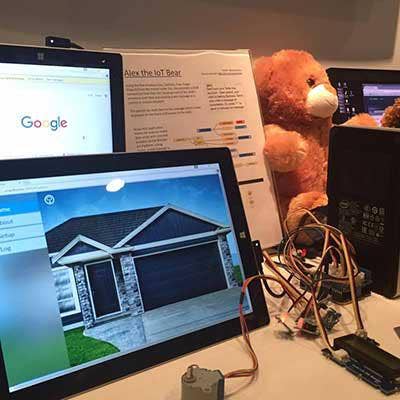
IBM Smart Teddy Bear
During Intel Developer Forum, IBM showcased an application for IoT that is a little more fun – an Internet of Things-enabled teddy bear. This bear has the capabilities to prompt a child to say how he or she feels, keeping track of the child's emotions over time and sending a text message to parents with the data.
The parent then has the option to reply back to the message containing this data, which is displayed on the toy's Grove LCD screen. For instance, if a child is feeling sad while his parent is traveling, the parent can send a message of consolation back to the teddy bear.
This connected toy uses a Node-RED application, the IBM Watson Internet of things platform for the cloud, and Twilio technology for VoIP and text messaging.
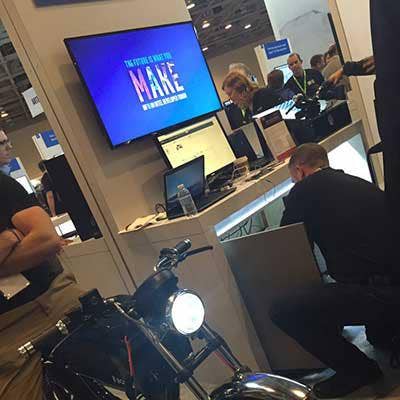
Cloud Connected Bolt Bike
A startup called Bolt Motorbikes displayed a cloud connected bike during Intel Developer Forum, which is a battery-powered bike and motorcycle hybrid. The bike is connected through Intel's Wind River Helix device cloud to capture and track data, and then analyze that data.
With these tracking capabilities, bikers can be notified when their bike tires are low, what their battery life is, or traffic patterns. Bolt is also currently testing a feature that only allows bikes to ride in areas where the driver permits them to – so if a bike gets stolen, it will not be able to operate outside of certain locations.
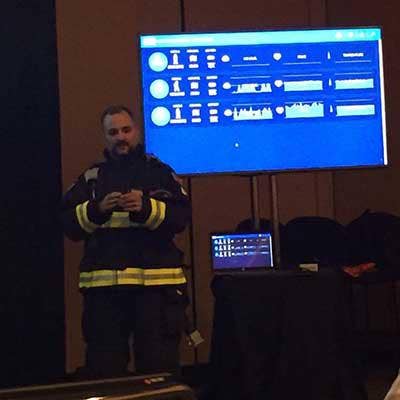
Intel Connected Firefighters
Intel during a technical session showed how it was utilizing its Internet of Things platform to help deploy connected solutions for firefighters.
As part of this solution, Intel connected a Quark processor to the firefighters' self-contained breathing apparatus, so that while they are in dangerous areas others can track how much oxygen they have left in their tank – and ultimately make critical life decisions based on that information.
Firefighters are also equipped with a pulse gesture device and activity detector, so that operators can receive that sensory information through Wind River Helix software and track whether they are signaling for help or are in a crawling position.
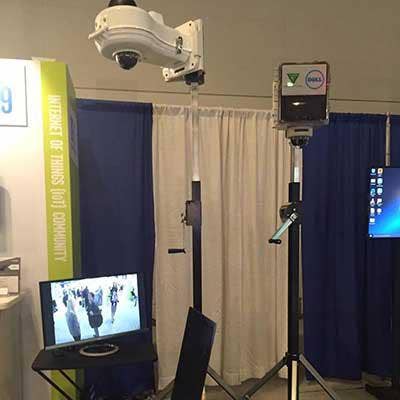
V5 Systems Security Unit
Solution provider V5 Systems approaches the Internet of Things from a security standpoint, with outdoor security solutions and platforms for the industrial IoT.
For example, its potable security unit is an intelligent device with wireless, multi-ensor, portable capabilities. This edge computing IoT device features advanced on-board analytics, proprietary power management system, on-board storage and communications.
Its products, such as V5 PSU-AC, enables streaming video over Wi-Fi and can extend security systems outdoors – so customers can track buildings for surveillance purposes and analyze that data.
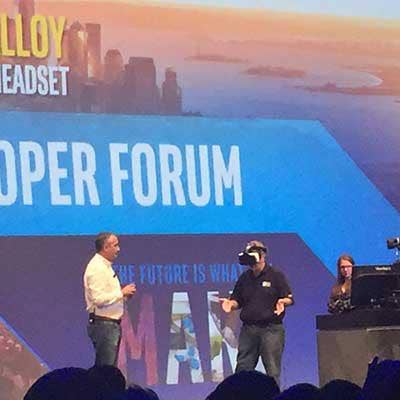
Project Alloy
Intel unveiled Project Alloy, its wireless virtual reality headset that leverages its RealSense 3-D camera technology, which will be part of Windows Holographic, so Windows 10 PC users can utilize head-mounted displays to interact with 3-D applications.
Intel, which in the past has leveraged its RealSense technology as part of its virtual reality strategy, on Tuesday showed how Project Alloy pushed those limits.
The headset is completely wireless, can track the user's hands for interacting with virtual reality, and – unlike other headsets like Oculus Rift and HTC Vive – doesn't rely on a PC for processing power.
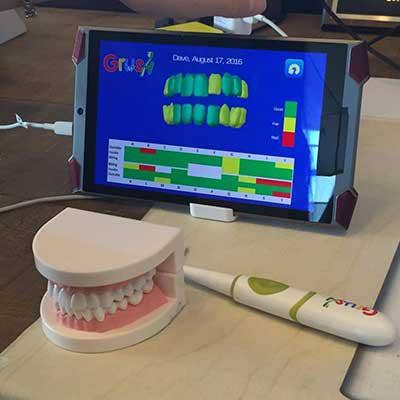
Grush
The winners of Intel's "America's Greatest Makers" competition created "Grush," an Internet of Things-connected toothbrush. This toothbrush records data of where children are brushing, and connects to an app that makes the brushing a real-time game.
This invention makes brushing exciting for children, and allows parents to track their kid's brushing to make sure they aren't missing any spots.
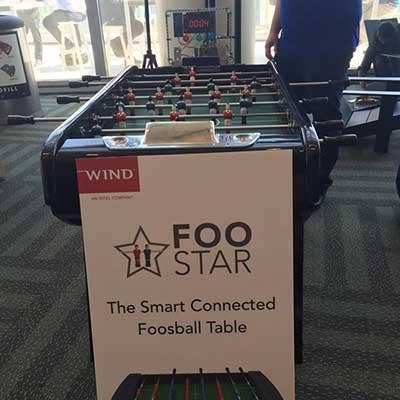
Wind RiverConnected Foosball Table
Intel's subsidiary Wind River has developed an Internet of Things foosball table, called Foo Star. This smart connected foosball table packs an Intel Edison and Intel Galileo for IoT-enabled foosball matches. This table records scores and other data to track games while users play.
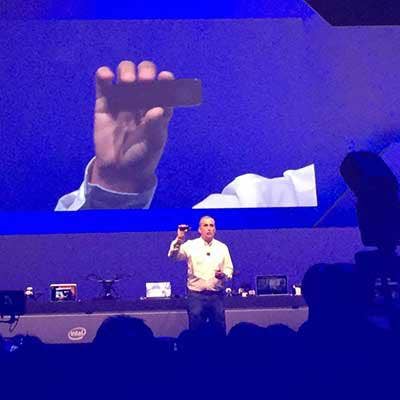
Joule Module
One of IDF's bigger announcements was Intel's unveiling of Joule, a module built for IoT applications by packing a high-performance system-onmodule into a low-power package.
According to Intel, this Edison successor features high-end compute, 4K video and large memory capabilities, as well as support for RealSense technology and other Intel software tools.
Joule is available in two models – 550x and the higher-performance 570x – and the developer kit will begin shipping in September through Intel reseller partners.
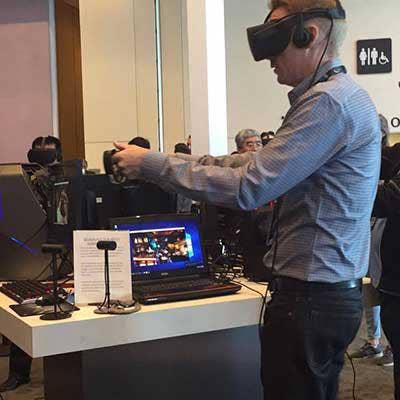
Oculus With Intel Software Development Tools
Users got to test out FaceBook's Oculus headset and other virtual reality tools during Intel Developer Forum. Users could teleport into a virtual code battle VR arena and use Intel Software Development Tools to clear out virtual enemies.
Pre-orders for the long-anticipated Oculus Rift, Facebook's new virtual reality headset, began in 2016 for $600. This headset is "the easiest way to introduce non-gamers to VR," according to Oculus.
Oculus Rift comes with a mic, sensor, the Oculus Remote, and an Xbox One controller, making it perfect for a variety of games.

Realsense-Enabled DJ Instruments
Before Intel CEO Brian Krzanich's keynote at Intel Developer Forum, musicians took the stage to show how Intel technology was helping innovate their instruments.
A pianist used Intel's depth-sensing RealSense technology to play his instrument without having to touch the keys, while a drummer used an augmented reality headset to help play the drums.
As part of the conference, Intel expanded its RealSense capabilities with a RealSense ZR300 development kit – combining depth-sensing with high-precision motion tracking, which is ideal for augmented reality, autonomous robotics and drones.
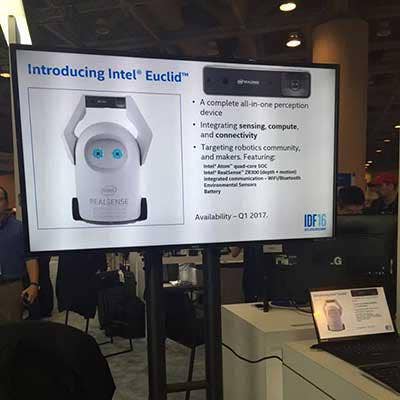
Euclid
Intel unveiled its all-in-one RealSense device Euclid, a device that enables developers to bring sensors to any robot.
This RealSense module packs a camera, an Intel Atom processor, a battery, and on-board communications. It runs Ubuntu Linux and Robot OS, and is packed into a candy-bar-sized form factor. This technology is ideal for researchers, makers and robotics developers.
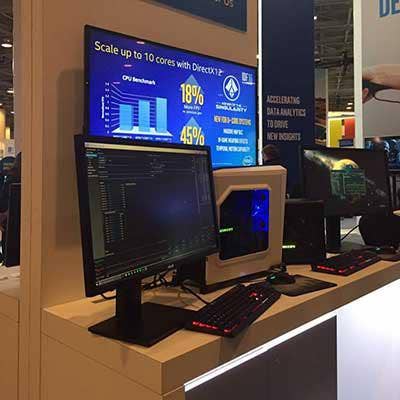
Extreme Edition Processors
Intel showcased the capabilities of its recently released Core i7 Extreme Edition desktop processors for enthusiast systems.
These high-end processors, which run on Intel's Broadwell architecture, are meant for high-end desktops. They feature improved specs, running at 3GHz with boosted speeds of up to 3.5GHz.
According to Intel, the Core i7 Extreme Edition's i7-6950X model is almost 35 percent faster than its predecessor, the Haswell-generation i7-5950X model. The i7-6950X model starts at $1,723.
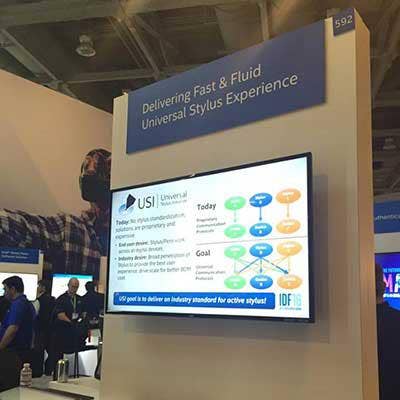
Universal Stylus
Intel outlined the Universal Stylus Initiative on its conference show floor. This initiative addresses an issue that manufacturers face with stylus accessories – a lack of standardization.
This standard would result in an active stylus capable of two-way communication with the device it is paired with. With this technology, users will be able to utilize the same stylus across touch-enabled devices such as phones and tablets as long as the device's touch controller is compliant with the USE 1.0 specification.
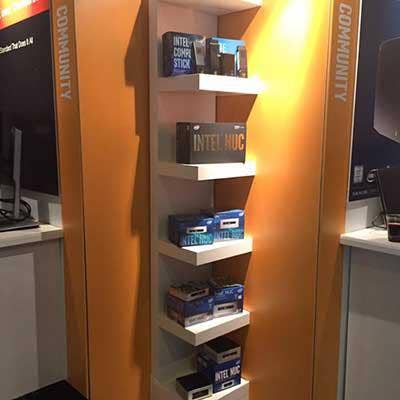
Skull Canyon NUC
Intel displayed its Skull Canyon NUC – the code name for its Next Unit of Computing mini PC kit that system builders can gear toward digital signage, media centers and kiosk solutions.
Skull Canyon, which became available in May, packs a sixth-generation Intel Core i7-6770HQ processor that expends 45 watts, as well as an integrated higher-end Iris Pro graphics 580 chipset.
The NUC also contains support for newer ports, including Thunderbolt 3, USB 3.1 and DP1.2. There are also four USB 3.0 ports and a full-size SD slot.
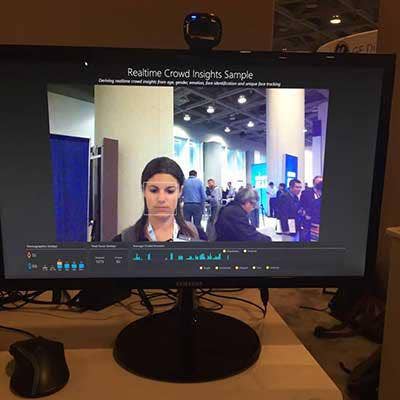
Microsoft Realtime Crowd Insights
Microsoft's Realtime Crowd Insights technology was displayed on the show floor at Intel Developer Forum. This is essentially a camera that scans the room and a monitor displaying the captured images.
This monitor can track the faces that pass by and analyze them, estimating features like gender, age and emotions. This technology can be applied to retail settings, so that retail stores can track how customers react to their products or advertisements in real time.
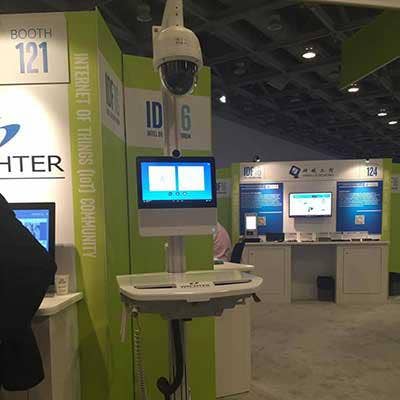
Wachter Virtual Patient Observation Solution
Solution provider Wachter works with Intel, Cisco and ISV Davra Networks to deploy Internet of Things solutions in the health-care space.
The company showcased its Virtual Patient Observation solution at Intel Developer Forum – a solution that helps nurses in hospitals keep track of, observe, and respond to patients in multiple locations in real time, addressing challenges that hospitals have in tracking patients and making workflow more efficient.
The solution uses Davra Network's Internet of Things software Application Enablement Platform, which combines telemetry and telematics data management with enterprise networking and video management. Wachter also provides sensors, monitors, cameras and access control for a variety of other applications in the Internet of Things space.